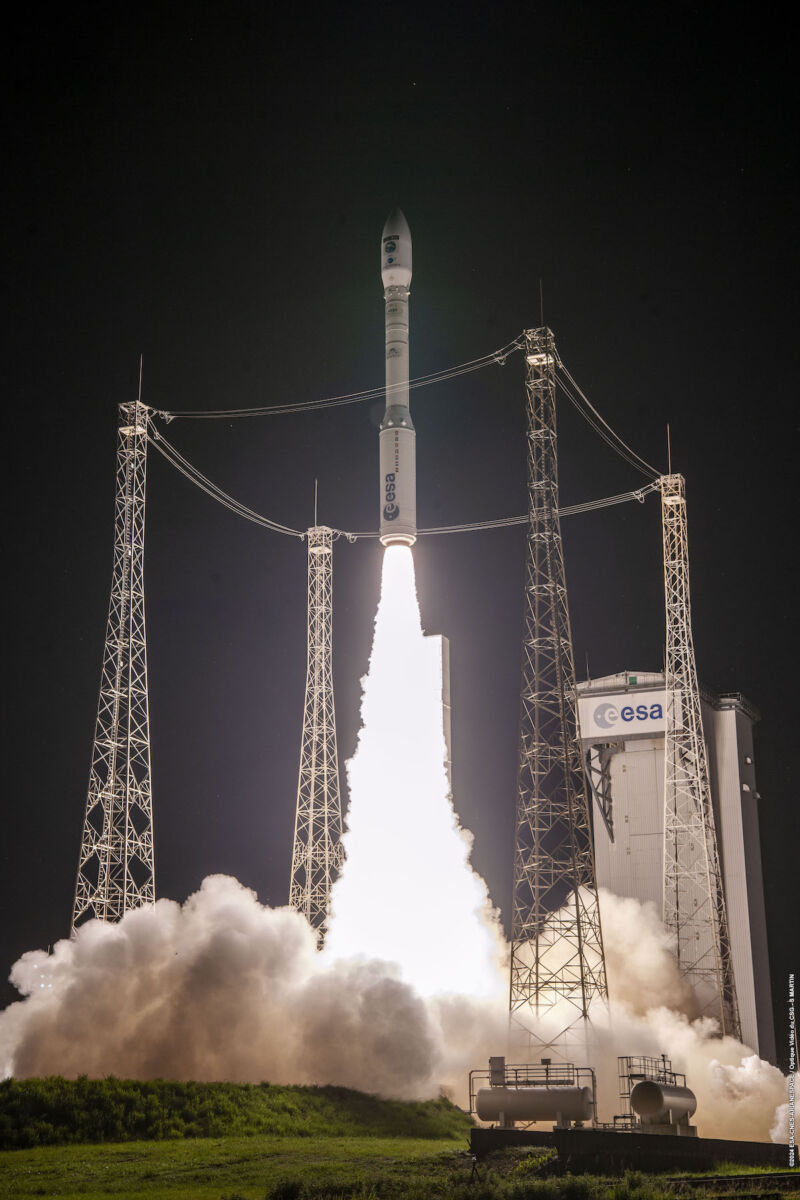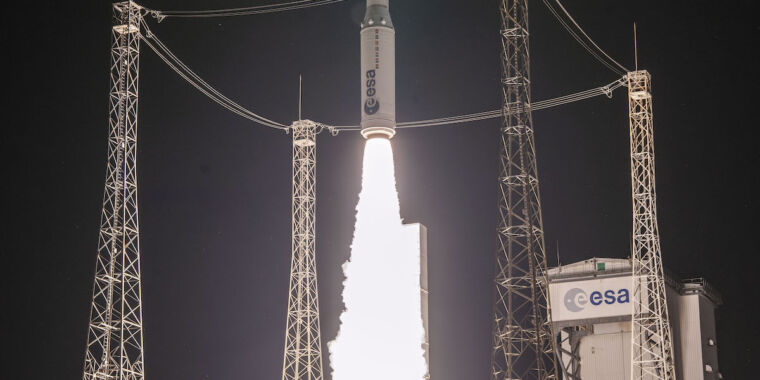
The final flight of Europe's Vega rocket took off from French Guiana on Wednesday evening, carrying a key environmental monitoring satellite for the European Union's flagship Copernicus programme.
The 98-foot (30-meter) tall Vega rocket lifted off at 9:50 p.m. EDT Wednesday (01:50 UTC Thursday) from the European-run spaceport in Kourou, French Guiana. The launcher flew north from the launch pad on the coast of South America, aiming for a polar orbit about 480 miles (775 kilometers) above Earth.
The sole payload was Sentinel-2C, a remote sensing platform that will join Europe’s fleet of Copernicus environmental satellites. The multibillion-dollar Copernicus system is the world’s most comprehensive space-based Earth observation network, with satellites equipped with a variety of instruments that monitor land surfaces, oceans and the atmosphere.
Sentinel-2C will replace Sentinel-2A, which was launched on a Vega rocket in 2015 and is nearing the end of its life. An identical satellite called Sentinel-2B has been in orbit since 2017 and will be replaced by Sentinel-2D in 2028.
About an hour after launch, the Vega rocket's upper stage released Sentinel-2C into an on-target orbit. Sentinel-2C then radioed its status to ground controllers, confirming that the satellite was healthy in space.
Similar to the U.S. government’s Landsat satellites, Europe’s Sentinel-2 series of spacecraft provide wide-angle optical views of crops, forests and urban areas to track seasonal and annual changes. The European Commission, the executive arm of the European Union, shares all Copernicus data free of charge with users worldwide.
The Vega launcher is powered by three solid-fuel rocket engines that fire in sequence and a liquid-fueled upper stage, the AVUM (Attitude Vernier Upper Module), that fires its engine multiple times to place satellites into slightly different orbits. Vega can deliver up to 3,300 pounds (1,500 kilograms) of payload mass to an orbit of 435 miles (700 kilometers).
Avio, an Italian aerospace company, designed Vega and oversees an industrial consortium that produces solid engines, structures and avionics for the rocket. From the beginning, Arianespace, the French launch service provider, has been responsible for marketing and sales of the Vega program.
The Vega rocket will be replaced by the larger Vega-C rocket, with a more powerful booster stage and a wider payload fairing. One of the main purposes of Vega-C will be to launch future Copernicus satellites for Europe.
“I think it was a great success,” Avio CEO Giulio Ranzo said in an interview with Ars a few hours before Wednesday night's mission. “It was our first launcher. It was our first experience as a major player in the launcher space. We built it from a blank sheet of paper, so the legacy is very, very strong. We learned a lot.”
22 and ready
In twelve years of service, however, the Vega rocket never really got a foothold in the commercial launch market. It averaged about two flights per year, mainly deploying satellites for the European Space Agency and other European government agencies, which prefer to launch their payloads on European rockets.
In the first few years after its launch in 2012, it seemed that the Vega rocket would have a chance of winning contracts to launch small Earth observation satellites for commercial companies and government customers outside Europe.
A Vega rocket launched an Earth-imaging satellite for Kazakhstan in 2013, and subsequent missions have placed similar satellites into orbit for the governments of Peru, Turkey and Morocco. For those missions, the governments enlisted European manufacturers Airbus Defense and Space and Thales Alenia Space to build the satellites and manage their launch contracts. Airbus and Thales chose Arianespace, another European company, to launch those satellites on Vega rockets.
In 2019, a Vega rocket failed during the launch of a military reconnaissance satellite for the United Arab Emirates, ending a streak of 14 successful flights in a row, a remarkable record for a brand new launch vehicle.
A year later, another Vega rocket failed to reach orbit, destroying two Spanish and French satellites. Just two years after the Vega rocket began flying, the European Space Agency (ESA) approved the development of its replacement, the Vega-C, to be able to handle heavier payloads.
“We were able to perfect certain subsystems in Vega that were greatly improved in Vega-C,” Ranzo said. “It was what it was supposed to be. It was supposed to be our first experience, and in 12 years we learned a lot and put everything we learned into a new version of the rocket.”
Vega-C was first successfully launched in July 2022, but failed on its second flight five months later. The rocket has not flown since then, and engineers have redesigned the nozzle for Vega-C's second stage solid rocket motor to fix the problem that led to the December 2022 failure.
The Vega rocket’s reliability issues coincided with growing competition in the commercial launch market. Vega, based on an interchangeable design, was too expensive to compete with SpaceX, which began offering rideshare flights on its workhorse Falcon 9 rocket in 2021.

